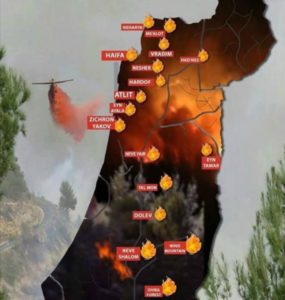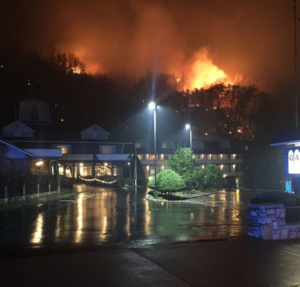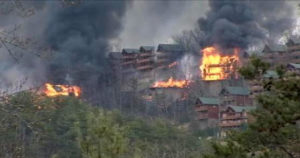By: Robert Avsec, Executive Fire Officer
Fire. One of the earliest weapons of war, and terrorism.

Map showing active wildfires throughout the nation of Israel.
And it continues to be so today. The nation of Israel has forest fires burning from one end of the country to the other. In the southeastern United States, wildfires are destroying mountainous forest lands and small towns.
Both here and abroad, many of those fires were intentionally set; enemies of Israel are suspected in the former, while individuals (with no known agenda or ideology at this time) have deliberately set fires in the western mountains of North Carolina and South Carolina, and the eastern mountains of Tennessee.
Particularly in those U.S. fires, entire towns have been evacuated and hundreds of structures have been destroyed; popular tourist towns like Gatlinburg and Pidgeon Forge in Tennessee have been particularly hard hit and those fires are still out of control as I write this.
(And let us not forget the catastrophic wildfires that ravaged the Fort McMurray area of Alberta, Canada in May 2016).
Fire as a Weapon is Not a New Concept
Early thermal weapons, including fire have been used in warfare beginning as far back as the classical and medieval periods (circa 8th century BC until the mid-16th century AD) to destroy or damage enemy personnel, fortifications or territories.
Development of those early weapons has continued ever since, with modern war weapons such as napalm, flame throwers, and other explosives having direct roots in the original early thermal weapons. Fire-raising and other destructive strategies can still be seen in modern strategic bombing.
So, what’s My Point?

Wildfires rage above and around Dollywood Theme Park in Pidgeon Forge, TN.
If we thought the high-jacking of airliners and flying them into buildings was “low tech” terrorism, I doubt we’ve seen nothing yet. We can rest assured that those terrorist elements that would do harm on U.S. soil are “taking notes” about the devastation being created by these intentionally set forest fires, the chaos being created in the local populations, and the stress on firefighting resources and other emergency response assets in those communities.
And then there’s the short-term and long-term effects:
- Short-term. Landslides and flash flooding when rains start falling on deforested mountain terrain, and later when melting snow starts running off those same lands in the spring.
- Long-term. The rebuilding of structures and infra-structure destroyed or damaged by the fires. The rebuilding of same when those inevitable landslides and flash floods occur. This “double whammy” is going to be exacerbated by the fact that many of the affected areas were already economically depressed and are going to have a very difficult time finding the funds to rebuild.
So back to the terrorism angle of this. Who needs “dirty bombs” and IEDs when a pack of matches is all you need? (Isn’t it a sad commentary on our times that I don’t feel the need to tell you what an IED is?).
When setting a forest afire is one of the easiest arson fires to set and your chances of being caught are pretty slim? When the lasting consequences of your terrorist act will affect communities and the entire country for months, if not years?
What we need to Do Now
We need to start preparing our communities for such a reality because it can happen anywhere at any time. Overall,

Fire destroys resort condominiums above town of Pidgeon Forge, TN.
33 percent of the United States is covered by forested lands. (FYI, Maine [90 percent] and West Virginia [74 percent] are the two most heavily forested states in the Union). Many areas of the United States are in the midst of historic draughts (a big factor in the rapid growth of the fires in the southeast). Here are some thoughts I have on what we need to start doing NOW:
- Actively promote the NFPA’s Firewise Communities Program across the U.S. Firewise encourages local solutions for safety by involving homeowners in taking individual responsibility for preparing their homes from the risk of wildfire. Firewise is a key component of Fire Adapted Communities – a collaborative approach that connects all those who play a role in wildfire education, planning and action with comprehensive resources to help reduce risk.
- Train all firefighters in wildland firefighting principles and practices regardless of what kind of community they serve on a daily basis. When the “manure hits the oscillating device”, it’s going to be an “all hands” response in many of these rural communities and they’re going to need quick reinforcements from their suburban and urban firefighting brothers and sisters.
- Train elements of the National Guard across the United States in wildland firefighting principles and practices for the same reasons. Also, review and streamline the process for state governors to activate and deploy those National Guard units more quickly. The key to keeping wildland fires, particularly in mountainous terrain, small and manageable is to hit them “hard and fast” and that means people.
- Provide those National Guard units with Type III engines (wildland firefighting engines) so that when they are deployed they have the tools they need.
- Provide the necessary NIMS (National Incident Management System) training to all civilian firefighters and National Guard personnel so that they can effectively work together when the time comes (and it will). Included in that training must be both tabletop and in-field exercises to promote safety, effectiveness and efficiency.
In the words of noted public safety risk management expert, Gordon Graham, “Predictable is preventable.” Will we be ready?
 Fire & EMS Leader Pro The job of old firefighters is to teach young firefighters how to become old firefighters!
Fire & EMS Leader Pro The job of old firefighters is to teach young firefighters how to become old firefighters!